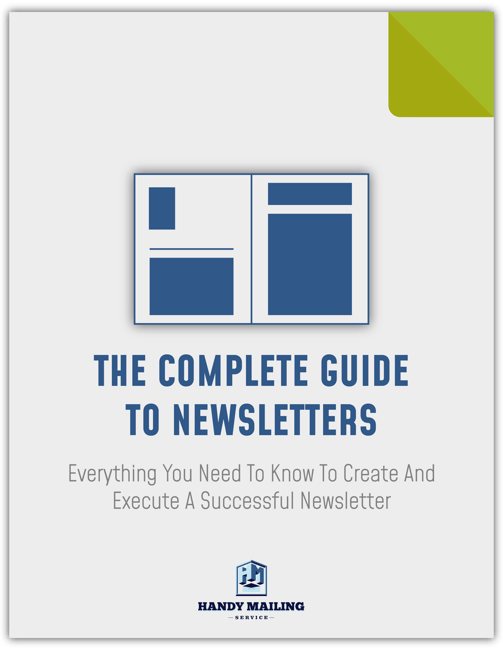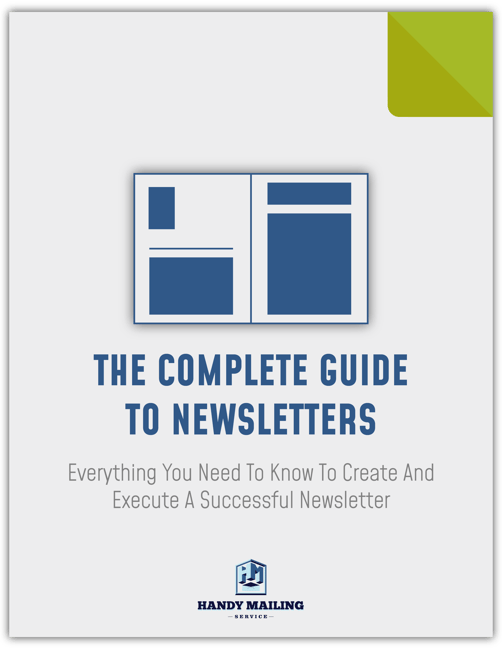Learn Everything You Need To Know To Create And Execute A Successful Newsletter
In this guide, you’ll discover why a newsletter is effective, how you can create one, and what practical steps are necessary to bring it to life. Whether this is completely new to you, or it’s already a staple in your marketing, you’ll gain valuable insights on how to run a successful newsletter.
Sustainable success takes discipline, strategy, and an actionable plan. After reading, you’ll understand the key attributes to developing consistency, thoughtful strategy to creating relevant content, and applicable next steps to make it happen!
Continue reading to learn how your newsletter can become a sales driving force and produce the results you’re looking for. You can also use the links to the right to jump to a specific section.
Section 1: What Is A Newsletter?
When created and used strategically, a newsletter can be your most effective sales piece. It’s a vessel to drive conversions, nurture relationships, and delight your reader. With limitless options and varieties, you can create and publish your own efficient, high- performing newsletter right now.
Types of Newsletters
There are two types of newsletters you can create: an e-newsletter or a print newsletter. Although the principles and strategies behind them are similar, the biggest difference is format and delivery. One is electronic and one is a physical copy. Let’s look at the different variables within each type of newsletter.
E-Newsletter
An e-newsletter is a newsletter formatted and sent via email, electronically. Thus where the “e” comes from. This is a digital format where your readers will likely open and read it within their email browser. Typically, it’s formatted in a continuous, vertical single column similar to a social media feed on your phone. The reader begins at the top and scrolls down as they read further.
Another option used less often is an e-newsletter sent attached as a PDF or JPG. The reader opens the attachment inside the email and reads it within the respective program. If sent as a PDF, it has more of a “book feel,” with pages the reader can work through. A PDF also allows your reader to print your newsletter in a more readable format than email.
Print Newsletter
A print newsletter is a physical piece printed on paper. It has actual weight and feel, giving the reader something to hold as they read. Typical sizes for a print newsletter are either 11” x 17” (4 pages) or 8.5” x 11” (2 pages). If you’re going to mail these to your customers without an envelope, you’ll need to fold them down to a final size of 5.5” x 8.5” to meet mailing standards. With an envelope, you can either leave it at 8.5” x 11” or down to 5.5” x 8.5.”
Because it's physical, you can choose a variety of papers to print on. The two most common paper types are 70# text or 80# gloss/dull text. The difference in paper selection comes down to thickness (how heavy the paper is), and finish (whether it’s glossy or matte). As with anything, the cost of each paper choice depends on the different aspects.
Another variable in a print newsletter is the use of color. With an e-newsletter, publishing it in color or black and white doesn’t make a difference with cost. With a print newsletter, color is more expensive than printing in black ink, which may alter your decision. A majority of our customers send their newsletters in color because they have images and graphics that look better in color. Of course, your budget will play a major role in the decision of using color or black and white.
How Often It’s Delivered
The other key attribute of a newsletter is the frequency at which it’s delivered. The three most common delivery frequencies are weekly, monthly, and quarterly. To determine frequency of sending your newsletter, you’ll need to consider budget and time.
An e-newsletter serving as a short and quick update is usually sent on a weekly basis or monthly basis. Whereas a print newsletter is sent as a more in-depth piece on a monthly or quarterly basis. Regardless of which type, the time it takes to compile and create the newsletter influences how often it's published. If you’re the one doing all the work, you might not have the time or resources to send a newsletter as often. But if you’re collaborating with others, you should be able to send one more often.
Section 2: Who Is A Newsletter For?
Perhaps the most critical factor to any successful newsletter is this: understand your audience. Without this foundation, you’re setting yourself up for failure.
So where do you start?
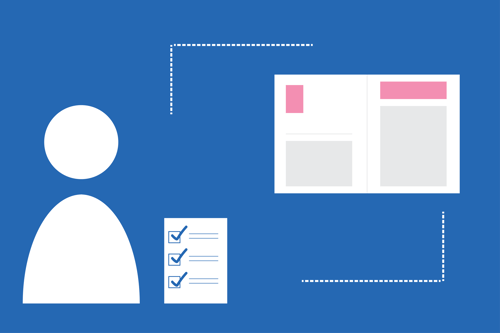
Define The Reader
First, do you understand who your reader is? You need to ask and answer several questions about your reader like: Who are they? What relationship do they have with you? Why should they read your newsletter? Are they gaining anything from reading?
Identify The Needs Of The Reader
If you don’t know the answers to these questions, you won’t have a focused direction. This “reader persona” needs to be your top priority when making any decision on the direction of your content. It’s your compass to keep you aligned with your goals. Use it as the standard for what belongs or doesn’t belong in your newsletter. Without a complete understanding of who your reader is, you won’t be able to tailor your content toward them. As a result, your newsletter will become irrelevant to the reader.
Second, have you identified the needs of your reader? Sure, it’s great if you know who they are, but you also need to know what their needs are. Because, if your newsletter is going to be relevant and worth reading, it has to provide solutions to their needs.
The readers of your newsletter want value, so the quickest and best way to appeal to your customers is to generate content that has this as its core. That’s not to say every newsletter needs to be a research paper. Value can come in the form of any of the following: entertainment, education, or sales. If you want your reader’s attention, you better deliver something worthy of their time.
Consider your relationship with your readers. Are you focusing your newsletter toward customers, prospects, or both? With that in mind, does that change what you include for them to read? The more you focus on their relationship with you, the more you can give them the content they’re looking for.
Once you’ve laid the groundwork and have clearly defined these different variables, begin paving the way with quality content. You know who they are and what they want to read, so now it’s the easy part. Start delivering it!
Section 3: What Are The Benefits Of A Newsletter?
Why Should You Send A Newsletter?
A newsletter is a substantial investment of time, effort, and resources. So what makes it worth it?
It’s a multi-dimensional piece that can accomplish several goals at the same time.
Because of its versatility, you can reach prospects and customers while giving them valuable content. You can use it to delight your customers after the sale or move along your prospect in the buyer’s journey. It can be educational, persuasive, and entertaining. You can include in depth articles, comics, company updates, and more. With so much flexibility, you can develop your relationship with customers and prospects alike.
Whether your focus is on driving more sales or nurturing relationships, a newsletter gives you the platform to achieve that mission.
What Makes It Effective?
Sending a newsletter on a consistent basis allows you to “touch” your reader more often. You’re probably familiar with the stats about how often you need to “touch” your prospects or current customers before each sale. This is another avenue you can do that in a friendly and non-intrusive way.
You can promote new products and services. You can run seasonal promotions and limited-time offers. Provide a personal feel by sharing a family update or a recent charity you supported. You have the opportunity to present yourself in a special way to your prospects and customers. By reading your newsletter, your reader develops a personal relationship with you and feels valued.
Deciding On Which Newsletter Is The Best Fit For You
As you read earlier, there are two types of newsletters: e-newsletters and print newsletters. Let’s look at the pro’s and con’s of each to identify which type is the best fit for you.
The Pros Of A Print Newsletter
-
Because it’s a tangible, physical piece, it engages more senses, leading to deeper comprehension and a stronger emotional bond.
-
You distinguish yourself from your competitors by sending a newsletter that grabs your readers undivided attention.
-
A printed newsletter tells your reader they’re worth the investment of your time and resources.
The Pros Of An E-newsletter
-
It’s cost efficient so you can create, produce, and send a high quantity with minimal investment.
-
By sending it via email, you can be confident your e-newsletter is delivered instantly, allowing you to be precise on timing.
-
You unlock a world of opportunity by including hyperlinks and calls-to-action for your readers to take immediate action.
The Cons Of An Print Newsletter
-
Printing and mailing newsletters can be costly especially when sending high quantities.
-
It can be harder to time when your reader will receive it, which can increase the difficulty of planning deadlines for offers.
-
Since it’s a paper piece, there’s no way of tracking if your reader received it or even opened it.
The Cons Of An E-newsletter
-
There’s a high probability it gets lost in the flow of other emails. And can come across as annoying if they didn’t sign up to receive your newsletter.
-
It can be difficult to hold the attention of your reader since they'll be distracted by so many other things on their computer.
Section 4: How To Design A Newsletter
When you hold a print newsletter in your hands or open an e-newsletter, what’s the first thing you notice? Is it the high quality writing or the witty humor used throughout? No, it’s the design!
Design draws readers into your newsletter, pulling them into the text and immersing them in the content. Like the cover of a book, it’s what your readers will judge first.
If you want people to read your newsletter, you need to create something that passes the eye test. You may not be an expert in this, so what are some ways to achieve this? The first place to start is deciding which program you want to design it with.
Picking The Right Program
There’s a plethora of different design programs out there that would be serviceable. Here are three in particular that might be a good fit for you based on your level of design experience.
- Adobe InDesign (Difficulty: Advanced)
- Canva.com (Difficulty: Intermediate)
- Microsoft Publisher (Difficulty: Beginner)
You can spend hours and hours researching which program suits your needs, but the key is to just get started! Understand the importance of design, but realize it doesn’t have to be perfect to be sufficient.
Creating Effective Design
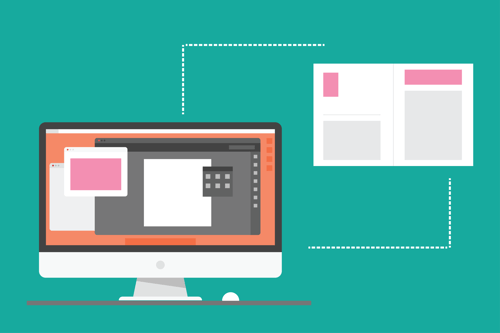
Now that you’ve picked a program to use, there’s not a magic button to create
something high-quality. Creating effective design takes time and focus. Here are some of the best practices that will keep you on track to creating a stellar newsletter design.
First, before diving into your work, have all your content ready. This will eliminate frustration and wasted time down the road. You need to decide what text is getting added (and what’s getting pitched) before adding images and graphics.
Second, understand how much content you have and organize it in a way that makes sense. You may need to be flexible with the size of your newsletter. This is especially true if you don’t have enough content to fill the entirety of the layout.
Third, achieve a cohesive appearance by using consistent color schemes, fonts and themes. When you develop consistency, your readers will begin to expect and recognize what you send. This will result in more engaged readers.
Fourth, organize your newsletter into a clear and distinguishable layout. Understand the hierarchy of importance within your content, and organize it accordingly. Doing so allows the reader to scan and progress through your content with ease.
Incorporating these ideas into your design does two things for your newsletter. 1. It makes it attractive and draws in readers. 2. It makes it easier to read and keeps your readers involved. As a result, your customers and prospects will read and retain more of your newsletter.
Section 5: Creating A Newsletter People Want To Read
What’s The Goal Of Your Newsletter?
Before brainstorming what content to include in your newsletter, you need to set a goal. Are you trying to entertain? Educate? Sell?
You’ve already defined who your reader is and what their needs are. By defining the goal of your newsletter, you create a measuring stick for creating the appropriate content.
Does Your Content Add Value To Your Newsletter?
Above all, this is the golden question you should be asking yourself before writing or inserting any type of content into the next issue.
Does this __________ (fill in the blank) add value to my newsletter?
By asking this question with each piece of content, you're holding yourself accountable to the standard you've set for your newsletter. This will prevent you from filling it with irrelevant stuff. Everything needs to provide value to the reader. Because in the end, if your newsletter doesn’t provide value to your reader, they’re not going to read it!
Quality Over Quantity
You might face the temptation to fill your next issue with the “easy” stuff. As an example: you’re drained of ideas but still have one page left, so you put a couple comic strips or recipes on there to fill up the space. Although those elements may fit your goal of entertainment, when used as an escape for a lack of content, you’re hurting the overall value of your newsletter.
Focus on quality instead of quantity. If that means trimming your newsletter from a four-page to a two-page one month, do it. Don’t feel pressured to fill the entire layout when you don’t have enough high-quality content for it. Your readers will appreciate a stellar two-page newsletter over a four-page newsletter lacking quality.
Where To Find Ideas For Good Content
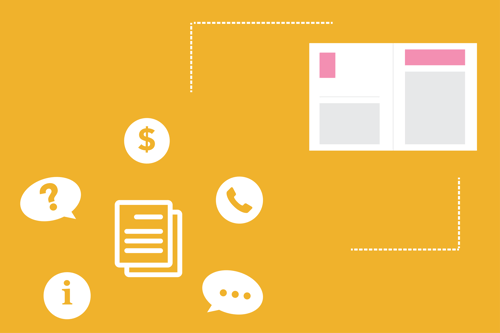
You might wonder, “where do I even start to create good content?” It’s easy, it’s within your own business. There are many places within your business where you can find high-quality content for your newsletter.
If your company has a sales team, find out what they encounter with your customers on a daily basis. Answer the questions and fears they receive consistently from prospects. Or, you can highlight how your prices and products compare against your competitors.
Marketing Team
Work with your marketing team to identify some of the interests of your prime demographic. Think of how you can help them and earn your customers’ trust by addressing what they care about.
Customer Service
Collaborate with your customer service team to discover the problems they’re solving on a regular basis. Dispel some of the fears your customers have by ensuring them about your company’s policies and values. Highlight ways your current customers have succeeded by using your products or service.
The Founders
Go straight to the people who started it all (this may even be YOU) and share the story of how it began. Highlight how your company has stayed true to its founding values and missions. Explore how your products or services continue to fulfill those same ideals.
Existing Products
Spotlight some of your products and services, explaining the value they offer to your customers. You can clarify their role and the problems they solve for your customers. Expand to your readers about who is your ideal customer and how they would benefit from your business partnership.
Focus on providing your readers authentic and valuable content. It doesn’t have to be flashy or “professionally written.” Be yourself and give your readers a genuine view of your company and yourself.
Section 6: Letting Your Newsletter Work For You
Consistency
Maximizing the productivity of your newsletter requires two characteristics: consistency and opportunity. Without these, you’ll never achieve the results you’re looking for in your investment.
Developing consistency requires sticking to a schedule. As you learned earlier, you need to decide on the frequency of your newsletter and stick to it. If you’re going to do it monthly, then do it every month! That means not taking months off because you’re limited on time or other responsibilities are making it difficult. It takes lots of discipline and hard work. Your newsletter has a compounding effect. The more you can continue to build it up at the beginning, the more you’ll be rewarded down the road.
Your readers will begin to anticipate your newsletter. When they’ve received it the first week each of the last six months, they’ll now expect it at the same time on the seventh month. It has become a part of their routine and something they look forward to. When you’ve reached that level of consistency, you’ve turned them from an interested reader into a committed member. They’re going to be more responsive to what you write and will look to participate. They’ll also develop a sense of loyalty to your newsletter and, ultimately, your business.
Opportunity
Now that you’ve gained their loyalty, you can give them opportunities to get involved. You can offer this opportunity through contests, promotions, activities, and more. Give them chances to win prizes. Run exclusive offers to people who respond to your newsletter. Turn your newsletter from an enjoyable read to a sales driving force.
By giving your readers opportunity to interact, they’re going to be more invested in what you have to say. They will feel valued and heard. And that will benefit you when they’re ready to make buying decisions.
One of the most effective ways to use your newsletter is through contests and promotions. Try running a referral contest for a set time-period and watch how your readers respond. It’s simple. Offer an exciting prize (worth your reader’s efforts) to the person with the most referrals. Make it clear what you would like them to do and how they can participate. Then, encourage them as the contest goes along via other channels like social media and email. Conclude with giving away the awesome prize and publishing the winner in your next newsletter, validating the contest.
Keep At It!
Establishing a performing newsletter is hard work! It takes time and months of consistency. If you’re feeling discouraged with how yours is performing right now, stay with it! Keep at it and don’t give up. If you keep providing your readers with helpful content and opportunities to get involved, you will reap the benefits for your effort. You got this!
Section 7: What To Know About Mailing A Print Newsletter
You’ve already read about the pros and cons of a print newsletter so it’s critical to understand the costs. And, the variables that can increase or decrease the cost of your newsletter. To decide what the best fit is for your budget and objectives, you'll need a comprehensive view of cost. This can be a driving force between picking an e-newsletter or a print newsletter.
Basic Costs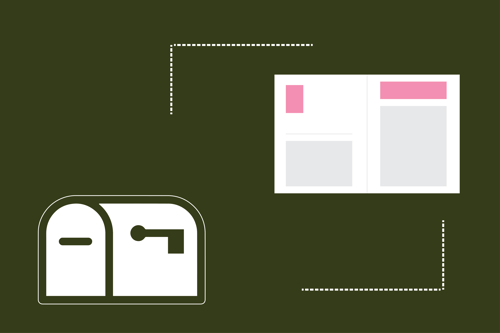
If you decide on a physical newsletter, you’ll need to consider three unavoidable costs: printing, material, and postage.
Printing transforms your digital artwork into a physical copy, and whether you’re printing or the mail house, you’ll need to consider the supplies. There are two options for how you can have your newsletter printed, color or black and white. Color is more expensive, but makes it visually striking. Black ink is budget friendly, but many of your graphics and images will lose their appeal. It’s a trade-off that you need to weigh the balance on for whether it’s worth the price or not.
After deciding on color, you’ll need to consider the paper to print on. There are a million and one options for what you can choose. With that variety, also comes a variety of cost. Take into consideration the “feel” you’re trying to establish. It might be worth paying for a more expensive paper if you’re going for a premium newsletter. If yours is purely an informative piece, then you’ll be fine with a basic text stock. From thickness to texture to colors, you have unlimited options with how you can customize your paper selection. It may take a few months of trial and error to decide on which is your best fit.
Once you produce your newsletter, you need to mail it to your recipients. The United States Postal Service provides this wonderful service. You’ll need to pick the postage class before mailing, each having different benefits and costs. Presort Standard is the cheapest but requires you to have a minimum quantity of 200 and takes the longest to deliver. First Class Full Rate delivers the fastest and will send you back your bad address returns, but costs the most. First Class Presort is slightly cheaper than First Class Full Rate, but requires a barcode like Presort Standard.
Options And Additions
If you’re still deciding on the length of your newsletter, the format can factor into the price. An 11” x 17” will cost more than an 8.5” x 11”. You might have to cut back on the amount of content to ensure you stay within your budget.
You’ll also need to decide whether to send your newsletter in an envelope or as a self-mailer. A self-mailer costs less, but the envelope feels more substantial. Once again, decide on which aligns best with your readers, objectives, and mission.
An insert can provide important benefits to what you’re promoting, but can increase the cost per newsletter. You can choose if you want it to be one-sided or two-sided, color or in black ink.
Your Mail House
All your efforts will be wasted if you don’t have a quality mail house who can produce your newsletter and mail it in time. They need to be cost efficient with their printing. They should be knowledgeable with their data processing. You need someone who is responsible and consistent to mail in a timely fashion. Without these three qualities, you’ll pay more than you should, mail to an inaccurate list, and send a low-quality newsletter.
Are You Using The Best Mail House? Read Our Free Ebook!
Section 8: Next Steps: Make It Happen!
You’ve learned everything you need to know about creating a newsletter, executing and publishing it. But where do you start?
A Simple Action Plan For You To Achieve Newsletter Success:
-
Define The Objectives, Reader, And Mission Of Your Newsletter
-
Decide On The Type, Format, And Frequency Of Your Newsletter
-
Pick A Design Program And Follow Design Best Practices
-
Brainstorm And Create Content Using Ideas Within Your Own Business
-
Provide Opportunities For Reader Participation
-
Choose An Expert Mail House Who You Can Rely On
-
Make It Happen!
Do you currently have a direct mail house? If you do, are you sure they’re the best fit for your needs?
Handy Mailing Service has been an expert in the direct mail industry since 1976. We currently send newsletters for over 50 of our clients on a monthly basis. With a wide spectrum of direct mail services, you can be confident your newsletter is produced with high-quality, in a timely fashion.
Click the button below, fill out the form, and get a FREE, no-obligation quote for your newsletter right now!

